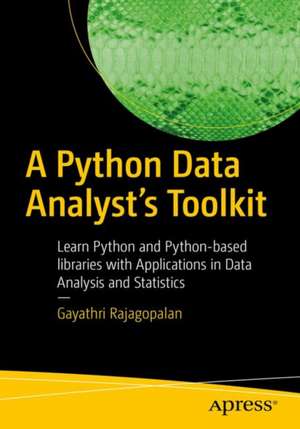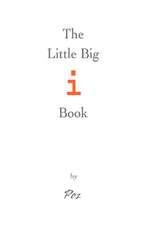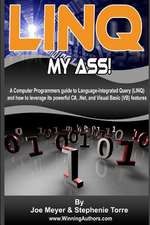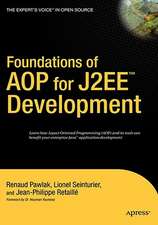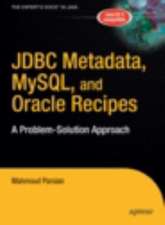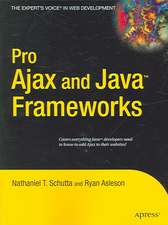A Python Data Analyst’s Toolkit: Learn Python and Python-based Libraries with Applications in Data Analysis and Statistics
Autor Gayathri Rajagopalanen Limba Engleză Paperback – 23 dec 2020
This book is divided into three parts – programming with Python, data analysis and visualization, and statistics. You'll start with an introduction to Python – the syntax, functions, conditional statements, data types, and different types of containers. You'll then review more advanced concepts like regular expressions, handling of files, and solving mathematical problems with Python.
The second part of the book, will cover Python libraries used for data analysis. There will be an introductory chapter covering basic concepts and terminology, and one chapter each on NumPy(the scientific computation library), Pandas (the data wrangling library) and visualization libraries like Matplotlib and Seaborn. Case studies will be included as examples to help readers understand some real-world applications of data analysis.
The final chapters of book focus on statistics, elucidating important principles in statistics that are relevant to data science. These topics include probability, Bayes theorem, permutations and combinations, and hypothesis testing (ANOVA, Chi-squared test, z-test, and t-test), and how the Scipy library enables simplification of tedious calculations involved in statistics.
What You'll Learn
- Further your programming and analytical skills with Python
- Solve mathematical problems in calculus, and set theory and algebra with Python
- Work with various libraries in Python to structure, analyze, and visualize data
- Tackle real-life case studies using Python
- Review essential statistical concepts and use the Scipy library to solve problems in statistics
Who This Book Is For
Professionals working in the field of data science interested in enhancing skills in Python, data analysis and statistics.
Preț: 270.63 lei
Preț vechi: 338.28 lei
-20% Nou
Puncte Express: 406
Preț estimativ în valută:
51.79€ • 54.32$ • 43.11£
51.79€ • 54.32$ • 43.11£
Carte disponibilă
Livrare economică 11-25 martie
Preluare comenzi: 021 569.72.76
Specificații
ISBN-13: 9781484263983
ISBN-10: 1484263987
Pagini: 391
Ilustrații: XX, 399 p. 169 illus.
Dimensiuni: 178 x 254 x 29 mm
Greutate: 0.73 kg
Ediția:1st ed.
Editura: Apress
Colecția Apress
Locul publicării:Berkeley, CA, United States
ISBN-10: 1484263987
Pagini: 391
Ilustrații: XX, 399 p. 169 illus.
Dimensiuni: 178 x 254 x 29 mm
Greutate: 0.73 kg
Ediția:1st ed.
Editura: Apress
Colecția Apress
Locul publicării:Berkeley, CA, United States
Cuprins
Chapter 1: Introduction to Python.- Chapter 2: Exploring Containers, Classes & Objects, and Working with Files.- Chapter 3: Regular Expressions.- Chapter 4: Data Analysis Basics.- Chapter 5: Numpy Library.- Chapter 6: Data wrangling with Pandas.- Chapter 7: Data Visualization.- Chapter 8: Case Studies.- Chapter 9: Essentials of Statistics.
Recenzii
“It is very well designed for beginners and guides them step by step towards autonomy in using Python. … this book is a good pedagogic tool for those starting to use Python for data analysis, with practical applications and with some review exercises at the end of each chapter. For anyone who wants to start with Python without any knowledge in programming, this book is a good companion and can help the reader to quickly become confident in using Python.” (Sébastien Bailly, ISCB News, iscb.info, Vol. 72, December, 2021)
Notă biografică
Gayathri Rajagopalan works for a leading Indian multi-national organization, with ten years of experience in the software and information technology industry. A computer engineer and a certified Project Management Professional (PMP), some of her key focus areas include Python, data analytics, machine learning, and deep learning. She is proficient in Python, Java, and C/C++ programming. Her hobbies include reading, music, and teaching data science to beginners.
Textul de pe ultima copertă
Explore the fundamentals of data analysis, and statistics with case studies using Python. This book will show you how to confidently write code in Python, and use various Python libraries and functions for analyzing any dataset. The code is presented in Jupyter notebooks that can further be adapted and extended.
This book is divided into three parts – programming with Python, data analysis and visualization, and statistics. You'll start with an introduction to Python – the syntax, functions, conditional statements, data types, and different types of containers. You'll then review more advanced concepts like regular expressions, handling of files, and solving mathematical problems with Python.
The second part of the book, will cover Python libraries used for data analysis. There will be an introductory chapter covering basic concepts and terminology, and one chapter each on NumPy(the scientific computation library), Pandas (the data wrangling library) and visualization libraries like Matplotlib and Seaborn. Case studies will be included as examples to help readers understand some real-world applications of data analysis.
The final chapters of book focus on statistics, elucidating important principles in statistics that are relevant to data science. These topics include probability, Bayes theorem, permutations and combinations, and hypothesis testing (ANOVA, Chi-squared test, z-test, and t-test), and how the Scipy library enables simplification of tedious calculations involved in statistics.
You will:
- Further your programming and analytical skills with Python
- Solve mathematical problems in calculus, and set theory and algebra with Python
- Work with various libraries in Python to structure, analyze, and visualize data
- Tackle real-life case studies using Python
- Review essential statistical concepts and use the Scipy library to solve problems in statistics
Caracteristici
Explains important data analytics concepts with real-life applications using Python Includes multiple-choice and practice questions to bridge the gap between theory and practice Contains case studies to demonstrate how data analysis skills can be applied to make informed decisions and solve problems
